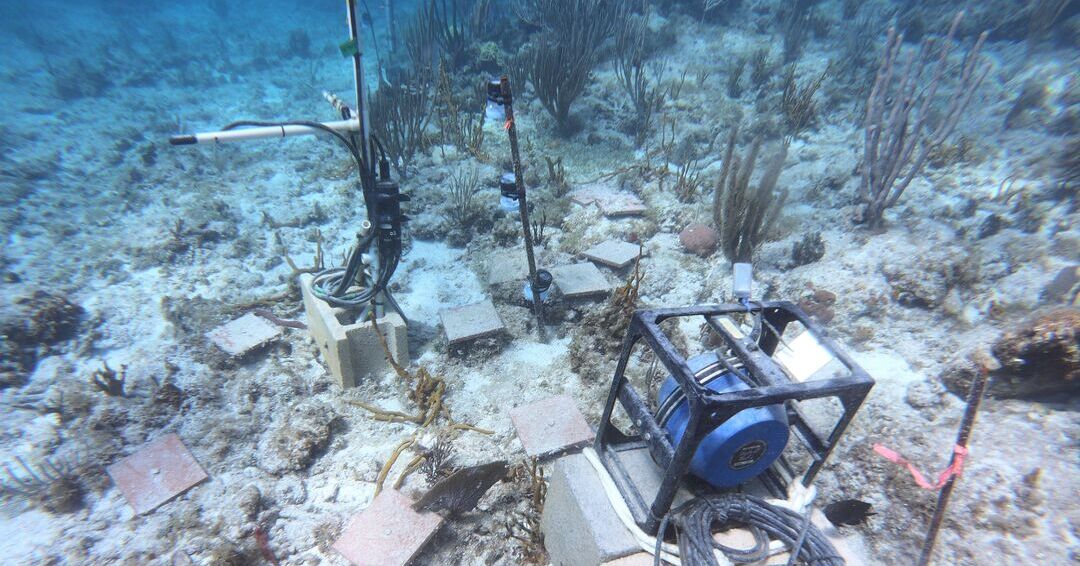Project title: Good vibrations: Increasing the capacity of acoustic enrichment applications for larval settlement and restoration
Project lead: Dr. Aran Mooney
Co-applicants: Dr. Gordon Zhang (M), Dr. J. Jacob Levenson (M), Mr. Simon Walsh (M), Dr. Gretchen Goodbody-Gringley
Countries involved: Dominica, Cayman Islands, USA
Takes place: Dominica, Cayman Islands, US Virgin Islands
Supporting institutions: Woods Hole Oceanographic Institution (USA), Oceans Forward (Dominica), Central Caribbean Marine Institute (Cayman Islands)
Total budget: USD $1,499,936
Duration: October 2024 – September 2027
Project overview
Coral reef ecosystems are critical for marine biodiversity and coastal protection, but their degradation poses a significant challenge for restoration efforts. One key to the survival and recovery of coral populations is the successful settlement of coral larvae. However, many reefs currently face low settlement rates due to declining coral populations and the absence of the natural cues that encourage larvae to settle. Traditional restoration methods, like outplanting, are time- and resource-intensive, making them difficult to scale effectively.
Recent studies have shown that coral larvae are capable of responding to environmental cues, such as sound, to find suitable habitats for settlement. Healthy coral reefs produce a rich soundscape from the activity of fish and other marine life, which attracts coral larvae. Conversely, degraded reefs lack these soundscapes, leading to reduced larval settlement. By mimicking these healthy soundscapes through acoustic enrichment (AE), it is possible to attract coral larvae to degraded areas and promote settlement.
The Reef Acoustic Playback System (RAPS) was developed to playback healthy reef soundscapes, providing a method to enrich the acoustic environment of degraded reefs. By attracting coral larvae to these areas, RAPS aims to create a positive feedback loop that restores the reef ecosystem.
This project aims to explore and optimize the use of acoustic enrichment to enhance coral larvae settlement across various coral species. It seeks to develop effective methods for applying this technique in real-world settings, incorporating environmental data such as temperature, salinity, and hydrodynamic currents. The project will collaborate with local restoration practitioners and stakeholders to refine these methods and achieve reef-scale restoration.
Specific Objectives
- Understand Coral Biology and Optimize Larval Settlement Through Acoustic Enrichment (AE) by studying coral larvae exposed to distinct sounds cues and in different environments to determine which are more effective.
- Conduct Field Tests by deploying RAPS systems and monitoring local conditions.
- Build System Efficiency and Capacity Through Learning Exchanges by collecting and integrating user-generated feedback.
How the Objectives Will Be Met
- Optimizing Larval Settlement Through AE:
- Conduct experiments with 3-6 key reef-building species (including: Orbicella annularis, O. faveolata, Montastrea cavernosa, Dichocoenia stokesii), testing their responses to various AE treatments and study their biology, including fertilization and growth.
- Use both field-collected and lab-raised larvae to measure settlement success under different acoustic conditions.
- Place larvae in controlled environments to observe settlement behavior with and without acoustic enrichment.
- Field Testing:
- Deploy RAPS in diverse locations across the US Virgin Islands, Dominica, and the Cayman Islands.
- Utilize environmental sensors around the Cayman Islands, and on the west side of Dominica to gather data on local conditions that might affect the efficacy of AE (temperature, salinity, currents)
- Test different site treatments (active AE, silent controls, and natural soundscapes) to evaluate their effectiveness in promoting coral settlement.
- Learning Exchanges and Feedback Collection:
- Host training workshops in each study area to educate local stakeholders on the use of RAPS.
- Leave RAPS systems with local users to gather long-term data and user feedback.
- Use feedback to refine and improve the system for broader application in coral restoration.
Impact of the Project
The project aims to deliver the following outcomes:
- Development of a robust and user-friendly tool for coral restoration practitioners to use in promoting larval settlement.
- Training of local stakeholders, including scientists, divers, local managers, and eco-tourism operators, in the application of acoustic enrichment techniques.
- Improved understanding of how different coral species respond to sound cues, contributing to more effective coral restoration strategies.
- Increased coral larval settlement in degraded reef areas, supporting the recovery and sustainability of coral ecosystems.
Major Highlights
- Utilizing sound cues to attract coral larvae and promote settlement, enhancing coral restoration efforts on degraded reefs.
- Building local capacity through training workshops and stakeholder engagement, fostering a community-based approach to reef restoration.
- Developing a scalable, low-cost method to support coral ecosystem recovery across multiple regions.
Photo: RAPS deployed in the field in off St. John, USVI. Credits: Aran Mooney, WHOI

